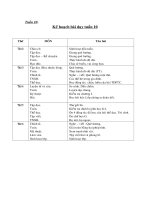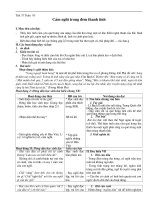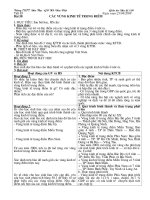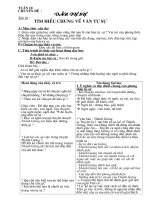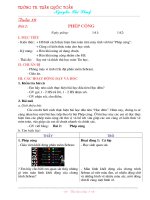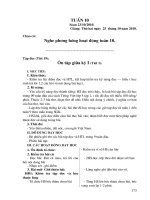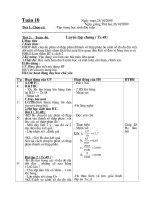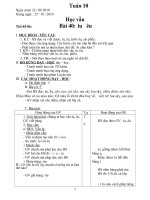GIÁO ÁN 9 THI DIEM- TUẦN 10
Bạn đang xem bản rút gọn của tài liệu. Xem và tải ngay bản đầy đủ của tài liệu tại đây (119.46 KB, 10 trang )
<span class='text_page_counter'>(1)</span><div class='page_container' data-page=1>
<b>UNIT 4: LIFE IN THE PAST</b>
<b>I. Objectives. </b>
- By the end of the unit, students will be able to:
+ use the lexical items related to life in the past
+ identify in which situations to stress auxiliary verbs in sentences and say these
sentences correctly
+ use “used/ didn’t use + to + infinitive to talk about past practices
+ express wishes for the present
+ make comments on or express opinions about the facts in the past
+ read for specific information about children’s pastimes in the past
+ listen for specific information about school life in the past
+ write a description of how children in the past studied without technology
- Skills: students will be developed 4 skills: speaking, listening, reading and writing.
- Political thought and moral sense: students will be educated to know more about life in
the past and be aware of preserving the past.
<b>II. Teaching aids. </b>
- Textbook, lesson plans, board, chalks, cues, posters, real objects, pictures,
computer and the CD record.
<b>III. Procedure.</b>
Lesson 1: Getting started
Lesson 2: A closer look 1
Lesson 3: A closer look 2
Lesson 4: Communication
Lesson 5: Skills 1
Lesson 6: Skills 2
Lesson 7: Looking back + Project
<b>Date of preparing: 18/10/2018 Period: 26</b>
<b>UNIT 4: LIFE IN THE PAST</b>
<b>LESSON 1: GETTING STARTED (P. 40-41)</b>
<b>A. OBJECTIVES: </b>
- By the end of this lesson, students will be able to listen and read the dialogue between
Nguyen and his father to understand the details then do some more tasks to understand
more about the past.
+ Vocabulary:
+ Grammar:
</div>
<span class='text_page_counter'>(2)</span><div class='page_container' data-page=2>
- Political thought and moral sense: educate students to know more about teen stress and
pressure and they will know how to cope with them.
<b>B. TEACHING AIDS: </b>
- Textbook, teacher’s book, lesson plan, board, chalks, posters, stereo and the CD record.
<b>C. METHODS: </b>
Chatting, presentation text, comprehension question, matching, gap-fill, discussion.
<b>D. CONTENTS: </b>
<b>I. Organization: (1 minute)</b>
<b>II. Revision / Warmer: (5 minutes)</b>
<i><b>* Chatting </b></i>
- Prepare some photos or magazine cut-outs about some common activities in the past
(twenty years ago) and at the present.
- Show them to Ss and let them group the pictures into the past or the present.
- Ask for an explanation of the groupings.
<b>III. New lesson: (37 minutes)</b>
<i><b>Activity 1: Presentation text ( part 1/p40)</b><b> (7 minutes)</b></i>
- Ask ss to open their books. Introduce Nguyen and his father. Ask Ss to guess where
they are and what they are doing. Brainstorm questions with Ss and write them on the
board.
What do you think the people in the coversation are talking about?
How do you understand the title ‘Preserving the past’?
- Accept all possible answers from ss and do not provide correction at this stage.
- T says: You’ll listen and read the dialogue.
- T gives the instructions: You look at the dialogue then listen to the tape.
- T turns on the tape twice.
- Ss listen and read.
- T calls two good students to read again the dialogues.
- T asks the others to correct.
<i><b>- T corrects Ss' mistakes. </b></i>
<i><b>Activity 2. </b><b> Comprehension question. ( Part 1a/p41)</b><b> (6 minutes)</b></i>
- T hangs the poster which has the contents of part 1.a/p41 on the board then runs
through.
- T gives the instructions: Read the conversation again and answer the questions.
- T models the first one.
1. Fathers make kites for sons.
- T checks Ss’ understanding.
</div>
<span class='text_page_counter'>(3)</span><div class='page_container' data-page=3>
- T gets Ss’ answers by dividing the class into 2 groups. One by one student from each
group comes to the board and writes the answer.
- T controls, corrects, gives marks then praises the winner.
<i><b>+ Answer key: </b></i>
1. Fathers make kites for sons.
2. Once every two months.
3. They used to come early, trying to find a place near the screen.
4. Only wealthy households.
5. Yes, he does. He said: “Sometime I wish I could go back to that time.”
<i><b>Activity 3. Match. ( Part 1b/p41) (6 minutes)</b></i>
- T shows the poster which has the contents of part 1b/ p.27 on the board then runs
through.
- T gives the instructions: Match the expressions from the conversations with their
meanings.
<i><b>- T models the first one. 1. c </b></i>
- T checks Ss’ understanding.
- Ss work with their partners in about 2 minutes.
- T gets Ss’ answers by dividing the class into 2 groups. One by one student from each
group comes to the board and writes the answer.
- T controls, corrects, gives marks then praises the winner.
<i><b>+ Answer key: </b></i>
1.c 2.a 3.d 4.b
<i><b>Activity 4. Match. (Part 1c/p41) (6 minutes)</b></i>
- T shows the poster which has the contents of part 1c/ p.27 on the board then runs
through.
- T gives the rule: Choose expressions from 1b to complete the conversations.
- T models the first one.
1. Sure.
- T checks Ss’ understanding.
- Ss work with their partners in about 2 minutes.
- T gets Ss’ answers.
- T checks and corrects.
<i><b>+ Answer key:</b></i>
1. Sure. 2. I can’t imagine that.
3. How cool! 4. I wish I could go back to that time. 5. How
cool! 6. I can’t imagine that.
</div>
<span class='text_page_counter'>(4)</span><div class='page_container' data-page=4>
- T shows 6 phrases in the box and 6 sentences in part 2/p41, then runs through.
- T asks Ss to replace words in italics with one of the words from the box.
- T models: 1.a
- T gives the instructions: Use the words/phrases in the box to complete the sentences.
- T checks Ss’ understanding.
- Ss work in pairs in 1 minute.
- T gets Ss’ answers.
- T checks and corrects.
<i><b>+ Answer key:</b></i>
1.a 2.d 3.c 4.b 5.e 6.f
<i><b>Activity 6: Discussion (Part 3/ p. 41) (6 minutes)</b></i>
- Have Ss work in a small group to come up with as many past events and practices as
possible which were part of daily life in their area.
- Give the groups a time limit, for example, five minutes.
- Have them present the list they have made to the class.
- As a whole class, decide if these practices were specific to their region or
neighbourhood or were also practiced elsewhere.
Example: Women in Hue used to go swimming at the beach fully clothed, to wear palm
leaf conical hats, to wear the traditional long dress whenever they went out, to stay at
home as housewives, to smoke…
<b>IV. Summary: (1 minute)</b>
- T asks one student to repeat the main contents of the lesson.
<b>V. Homework: : (1 minute)</b>
- Practice the dialogue.
- Finish all exercises at home
- Prepare the new lesson: Unit 4: Lesson 2: A closer look 1
<b>E. EVALUATION: </b>
...
...
...
...
<b>... </b>
</div>
<span class='text_page_counter'>(5)</span><div class='page_container' data-page=5>
<b>Date of preparing:18/10/2018 Period: 27 </b>
<b>UNIT 4: LIFE IN THE PAST</b>
<b> LESSON 2: A CLOSER LOOK 1 (P.42-43)</b>
<b>A. OBJECTIVES: </b>
- By the end of this lesson, students will be able to use some more words to talk about life
in the past, then practise the stress on the auxilary verbs in sentences.
+ Vocabulary: illiterate, street vendors, seniority.
+ Grammar:
- Skills: Practice and develop listening and writing skills.
- Political thought and moral sense: educate students to know more about life in the past
and educate them to love the subject more.
<b>B. TEACHING AIDS: </b>
- Textbook, teacher’s book, lesson plan, board, chalks, posters, stereo and the CD record.
<b>C. METHODS: </b>
Chatting, match and gap-fill.
<b>D. CONTENTS: </b>
<b>I. Organization: : (1 minute)</b>
<b>II. Revision / Warmer: : (5 minutes)</b>
<i><b>* Chatting </b></i>
- T asks Ss some questions.
- Good afternoon.
- How are you today ?
- Tell me some activities children often did in the past.
- Ss answer.
Suggested answers: play hide and seek, pay marble, play tag, play outdoor activities.
<b>III. New lesson: (37 minutes)</b>
<i><b>* Vocabulary. (27 minutes)</b></i>
<i><b>Activity 1. Match </b><b> (Part 1/ p. 42).</b></i>
- T shows the poster which has the contents of part 2/ p.28 on the board then runs
through.
- T gives the instructions: Match a ver in A with a word/phrase in B.
- T models the first one. 1.f
- T checks Ss’ understanding.
- Ss work with their partners in their tables in about 2 minutes.
- T gets Ss’ answers by dividing the class into 2 groups. One by one student from each
group comes to the board and writes the answer.
</div>
<span class='text_page_counter'>(6)</span><div class='page_container' data-page=6>
<i><b>+ Answer key: </b></i>
1.f 2.g 3.b 4. a 5. c 6. e 7. h 8. d
<i><b>Activity 2: Gap-fill (Part 2- p.42).</b></i>
- T shows the content of part 2 on the board then runs through.
- T gives the instructions: Use the newly-formed phrases in part 1 with the verbs in their
correct forms to complete the sentences.
- T models:
1. kept diary
- Ss work individually to do the task.
- Have some Ss compare their answers.
- T gets Ss/ answers and confirm them.
<i><b>+ Answer key: </b></i>
1. kept diary 2. entertain themselves. 3 preserve our traditions
4. Use your imagination 5. acting out stories 6. collect the post
7. giong bare-footed 8. dance to drum music
<i><b>Activity 3: Gap-fill (Part 3- p.42).</b></i>
- T shows the content of part 3 on the board then runs through.
- T gives the instructions: Choose a word/phrase from the box to complete the sentences.
- T models:
1. seniority
- Ss work individually to do the task.
- Have some Ss compare their answers.
- T gets Ss/ answers and confirm them.
<i><b>+ Answer key: </b></i>
1. seniority 2. illiterate 3. street vendors
4. strict rules 5. Physical 6. face to face
<i><b>Activity 4: Gap-fill (Part 4- p.42).</b></i>
- T covers the “remember! box”, Ss read the definitons.
- T shows the content of part 3 on the board then runs through.
- T gives the instructions: Using the right form of the words to complete the sentences.
- T models:
1. habit
- Ss work individually to do the task.
- Have some Ss compare their answers.
- T gets Ss/ answers and confirm them.
<i><b>+ Answer key: </b></i>
</div>
<span class='text_page_counter'>(7)</span><div class='page_container' data-page=7>
4. habit 5. practice 6. behaviour
<i><b>* Pronounciation: Stress on auxiliary verb in sentences. (10 minutes)</b></i>
<i><b>Activity 5. Listen and underline (Part 5 - p.43).</b></i>
- Ask Ss to note all the auxilaries they find in the sentences first.
- Discuss with thme which ones they think will be stressed.
- Play the recording.
- Ss listen and underline the stressed auxilaries.
- They repeat the sentences with a focus on the stressed ones.
- Since Ss often see auxilaries as unstressed, it is as good idea to give Ss some intisl
guidance from the REMEMBER! Box inder exercise 5 before the actually do the
exercise.
<i><b>+ Answer key: </b></i>
Sentences 1 and 2 contain no stressed auxilaries. 3. did 4. hasn’t
5. don’t 6. do
<i><b>* Activity 6. Listen and underline (Part 6- p.43)</b></i>
- Have Ss work individually to stressed the auxilaries.
- Ask them to refer to the REMEMBER! Box as they do the exercise.
- Then play the recording.
- Ss listen, check, and say the sentences.
- Call on some Ss to say the sentences individually.
<i><b>+ Answer key: </b></i>
1. couldn’t 2. have 3. contain no stressed auxilaries
4. aren’t/ can’t/ can 5. doesn’t/ don’t/ does
<b>IV. Summary: (1 minute)</b>
- T asks students to repeat the main contents of the lesson.
<b>V. Homework: (1 minute)</b>
- Finish execises A page 31- workbook.
- Prepare the new lesson: Unit 4: Lesson 3: A closer look 2.
<b>E. EVALUATION: </b>
...
...
...
...
</div>
<span class='text_page_counter'>(8)</span><div class='page_container' data-page=8>
<b>---Date of preparing:18/10/2018 Period: 28</b>
<b>UNIT 4: LIFE IN THE PAST</b>
<b>LESSON 3: A CLOSER LOOK 2 (P. 43-44)</b>
<b>A. OBJECTIVES: </b>
- By the end of the lesson, students will be able to review “used to” and “wishes” for
present.
+ Vocabulary:
+ Grammar: “used to” and “wishes” for present.
- Skills: practice and develop writing skills.
- Political thought and moral sense: educate students to know more about life in the past
<b>B. TEACHING AIDS: </b>
- Textbook, teacher’s book, lesson plan, board, chalks and the posters.
<b>C. METHODS: </b>
Multiple choice, gap-fill, ask and answer, sentence correction, write-it-up.
<b>D. CONTENTS: </b>
<b>I. Organization: (1 minute)</b>
<b>II. Revision / warmer. (5 minutes)</b>
- T calls on 3 students to read the sentences in exercise A on page 31 in workbook.
- Other Ss and T gives remark and marks.
<b>III. New lesson: (37 minutes)</b>
<i><b>* Used to: review. (17 minutes)</b></i>
<i><b>Activity 1: Multiple choice (Part 1/ p.43).</b></i>
- T shows the poster which has the contents of part 1 p.43 on the board then runs through.
- T gives the instructions: Read the conversation in “getting started” again. Underline the
examples of used to + infinitives. Then tick the correct answer.
- T checks Ss’ understanding.
- Ss work with their partners in their tables in about 1 minutes.
- T gets Ss’ answers.
- T corrects.
<i><b>+ Answer key: </b></i> <i><b>B </b></i>
<i><b>Activity 2. Gap-fill (Part 2/ p43).</b></i>
- T shows the poster which has the contents of part 2/ p.43 on the board then runs
through.
- T gives the instructions: Use “used to” or “did not use to” with the verbs from the box
to complete the sentences.
</div>
<span class='text_page_counter'>(9)</span><div class='page_container' data-page=9>
- T checks Ss’ understanding.
- Ask Ss to work in pairs to complete the task in about 2 minutes.
- T gets Ss’ answers by dividing the class into 2 groups. One by one student from each
group comes to the board and writes the answer.
- T controls, corrects, gives marks then praises the winner.
<i><b>+ Answer key: </b></i>
1. used to be 2. didn’t use to transport 3. used to dye
4. used to kill 5. used to pull out 6. didn’t use to spend
<i><b>* “Wishes” for present. (20 minutes)</b></i>
<i><b>Activity 3. Ask and answer (Part 3/ p.44)</b></i>
- T asks Ss to read the conversation in “getting started” again. Underline the main verbs
<i>in the wish sentence.</i>
- Explain the “look out!” Box.
- T shows 2 questions of part 3/ p.44 on the board then runs through.
- Ask Ss to answer the questions.
- T gets Ss’ answers, checks and corrects.
<i><b>+ Answer key: </b></i>
1. for the present
2. the past simple and past continue
<i><b>Activity 4. Sentence correction (Part 4/ p.44.)</b></i>
- T shows the poster which has the contents of part 4/ p.44 on the board then runs
through.
- T gives the instructions: Tick if the sentence is correct. If the sentence is not correct,
underline the mistake and correct it.
- T models the first one.
1. Correct
- T checks Ss’ understanding.
- Ask Ss to work in pairs to complete the task in about 2 minutes.
- T gets Ss’ answers by dividing the class into 2 groups. One by one student from each
group comes to the board and writes the answer.
- T controls, corrects, gives marks then praises the winner.
<i><b>+ Answer key: </b></i>
Correct: 1 and 4
</div>
<span class='text_page_counter'>(10)</span><div class='page_container' data-page=10>
- T shows the poster which has the contents of part 5/ p.44 on the board then runs
through.
- T gives the instructions: Make up wishes from the prompts.
- T models the first one.
1. I wish we could communicate with animals.
- T checks Ss’ understanding.
- Ask Ss to work in pairs to complete the task in about 2 minutes.
- T gets Ss’ answers by dividing the class into 2 groups. One by one student from each
group comes to the board and writes the answer.
- T controls, corrects, gives marks then praises the winner.
<i><b>+ Answer key: </b></i>
1. I wish we could communicate with animals.
2. I wish no child was/were suffering from hunger.
3. I wish I was/were playing on the beach.
4. I wish there was/were no more familiy violence in the world.
5. I wish I was/were going bushwalking with my friends.
6. I wish there were four seasons in my area.
<b>IV. Summary: (1minute)</b>
- T asks students to repeat the main contents of the lesson.
<b>V. Homework: (1minute)</b>
- Do the exercises: B1,2,3,4,5,6 p.31,32 in workbook.
- Prepare the new lesson: Unit 4: Lesson 4: Communication.
<b>E. EVALUATION: </b>
...
...
...
</div>
<!--links-->
